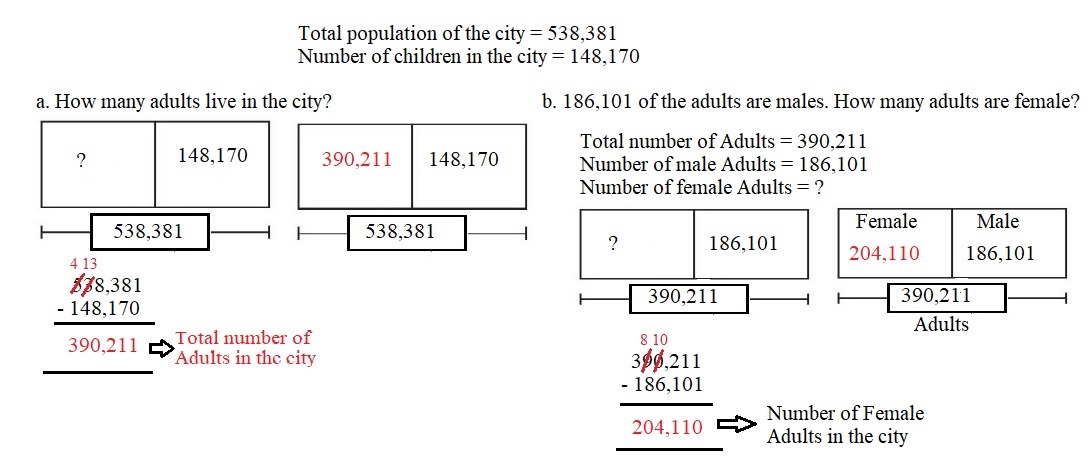Engage NY Eureka Math 4th Grade Module 1 Lesson 13 Answer Key2ureka Math Grade 4 Module 1 Lesson 13 Problem Set Answer Key
Question 1.
Use the standard algorithm to solve the following subtraction problems.
a. 
Answer:
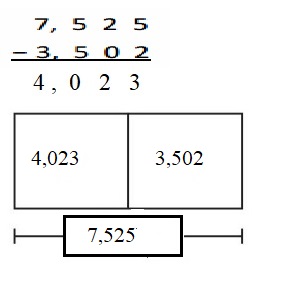
Explanation:
The rules of subtraction we first write the greater number at the top. Then subtract the digits column-wise ones from ones, tens from tens, hundreds from hundreds, thousands from thousands and so on.
Ones = 5 – 2 = 3.
Tens = 2 – 0 = 2.
Hundreds = 5 – 5 = 0.
Thousands = 7 – 3 = 4.
The number 7,525 is the minuend, the number 3,502 is the subtrahend and the number 4,023 is the difference.
b. 
Answer:
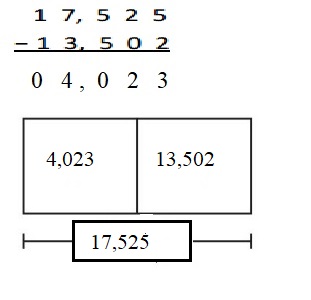
Explanation:
The rules of subtraction we first write the greater number at the top. Then subtract the digits column-wise ones from ones, tens from tens, hundreds from hundreds, thousands from thousands and so on.
Ones = 5 – 2 = 3.
Tens = 2 – 0 = 2.
Hundreds = 5 – 5 = 0.
Thousands = 7 – 3 = 4.
Ten thousands = 1 – 1 = 0.
The number 17,525 is the minuend, the number 13,502 is the subtrahend and the number 04,023 is the difference.
c. 
Answer:
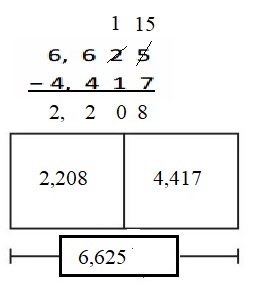
Explanation:
The rules of subtraction we first write the greater number at the top. Then subtract the digits column-wise ones from ones, tens from tens, hundreds from hundreds, thousands from thousands and so on.
Ones = 5 – 7 = 8.
5 is less than 7 so we borrow 1 from the 2 tens place and make 2 tens as 1 tens and make 5 ones as 15 ones and we subtract 7 from 15.
Tens = 1 – 1 = 0.
Hundreds = 6 – 4 = 2.
Thousands = 6 – 4 = 2.
The number 6,625 is the minuend, the number 4,417 is the subtrahend and the number 2,208 is the difference.
d. 
Answer:
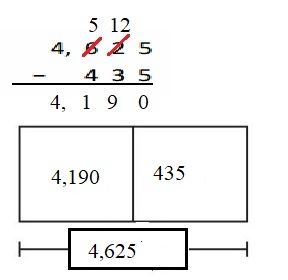
Explanation:
The rules of subtraction we first write the greater number at the top. Then subtract the digits column-wise ones from ones, tens from tens, hundreds from hundreds, thousands from thousands and so on.
Ones = 5 – 5 = 0.
Tens = 2 – 3 = 12 – 3 = 9.
2 is less than 3 so we borrow 1 from the 6 hundreds place and make 6 hundreds as 5 hundreds and make 2 tens as 12 tens and we subtract 3 from 12.
Hundreds = 5 – 4 = 1.
Thousands = 4 – 0 = 4.
The number 4,625 is the minuend, the number 435 is the subtrahend and the number 4,190 is the difference.
e. 
Answer:

Explanation:
The rules of subtraction we first write the greater number at the top. Then subtract the digits column-wise ones from ones, tens from tens, hundreds from hundreds, thousands from thousands and so on.
Ones = 0 – 0 = 0.
Tens = 0 – 7 = 10 – 7 = 3.
0 is less than 7 so we borrow 1 from the 5 hundreds place and make 5 hundreds as 4 hundreds and make 0 tens as 10 tens and we subtract 7 from 10.
Hundreds = 4 – 4 = 0 .
Thousands = 6 – 0 = 6.
The number 6,500 is the minuend, the number 470 is the subtrahend and the number 6,030 is the difference.
f. 
Answer:
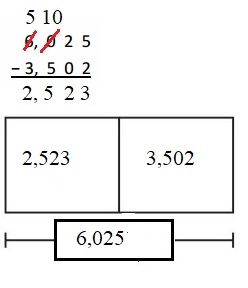
Explanation:
The rules of subtraction we first write the greater number at the top. Then subtract the digits column-wise ones from ones, tens from tens, hundreds from hundreds, thousands from thousands and so on.
Ones = 5 – 2 = 3.
Tens = 2 – 0 = 2.
Hundreds = 0 – 5 = 10 – 5 = 5.
0 is less than 5 so we borrow 1 from the 6 Thousands place and make 6 Thousands as 5 Thousands and make 0 hundreds as 10 hundreds and we subtract 5 from 10.
Thousands = 5 – 3 = 2.
The number 6,025 is the minuend, the number 3,502 is the subtrahend and the number 2,502 is the difference.
g. 
Answer:

Explanation:
The rules of subtraction we first write the greater number at the top. Then subtract the digits column-wise ones from ones, tens from tens, hundreds from hundreds, thousands from thousands and so on.
Ones = 0 – 0 = 0.
Tens = 4 – 3 = 1
Hundreds = 6 – 6 = 0.
Thousands = 3 – 4 = 13 – 4 = 9.
3 is less than 4 so we borrow 1 from the 2 ten Thousands place and make 2 Thousands as 1 ten Thousands and make 3 hundreds as 13 hundreds and we subtract 4 from 13.
Ten Thousands = 1 – 1 = 0
The number 23,640 is the minuend, the number 14,630 is the subtrahend and the number 09,010 is the difference.
h. 
Answer:
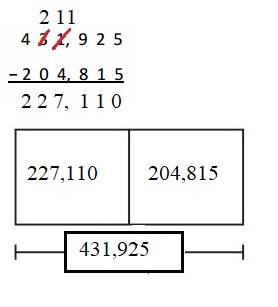
Explanation:
The rules of subtraction we first write the greater number at the top. Then subtract the digits column-wise ones from ones, tens from tens, hundreds from hundreds, thousands from thousands and so on.
Ones = 5 – 5 = 0.
Tens = 2 – 1 = 1.
2 is less than 3 so we borrow 1 from the 6 hundreds place and make 6 hundreds as 5 hundreds and make 2 tens as 12 tens and we subtract 3 from 12.
Hundreds = 9 – 8 = 1.
Thousands = 1 – 4 = 11 – 4 = 7.
1 is less than 4 so we borrow 1 from the 3 ten thousands place and make 3 ten thousands as 2 ten thousands and make 1 thousands as 11 thousands and we subtract 4 from 11.
Ten thousand =2 – 0 = 2.
Hundred thousand = 4 – 2 = 2.
The number 431,925 is the minuend, the number 204,815 is the subtrahend and the number 227,110 is the difference.
i. 
Answer:

Explanation:
The rules of subtraction we first write the greater number at the top. Then subtract the digits column-wise ones from ones, tens from tens, hundreds from hundreds, thousands from thousands and so on.
Ones = 5 – 5 = 0.
Tens = 2 – 0 = 2.
Hundreds = 9 – 7 = 2.
Thousands = 9 – 1 = 8
Ten thousand =1 – 2 = 11 – 2 = 9.
1 is less than 2 so we borrow 1 from the 2 hundred thousands place and make 2 hundred thousands as 1 hundred thousands and make 1 ten thousands as 11 ten thousands and we subtract 2 from 11.
Hundred thousand = 1 – 1 = 0.
The number 219,925 is the minuend, the number 121,705 is the subtrahend and the number 098,220 is the difference.
Draw a tape diagram to represent each problem. Use numbers to solve, and write your answer as a statement. Check your answers.
Question 2.
What number must be added to 13,875 to result in a sum of 25,884?
Answer:
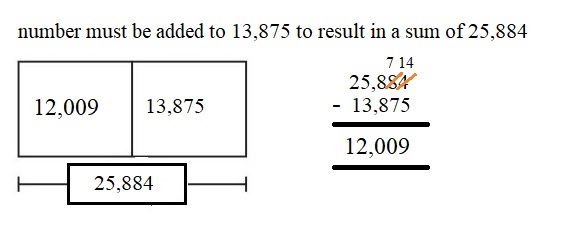
12,009 must be added to 13,875 to get the sum of 25,884.
Question 3.
Artist Michelangelo was born on March 6, 1475. Author Mem Fox was born on March 6, 1946. How many years after Michelangelo was born was Fox born?
Answer:
Artist Michelangelo was born on March 6, 1475.
Artist Mem Fox was born on March 6, 1946
The difference between the their years = 1946 – 1475 = 471 years.
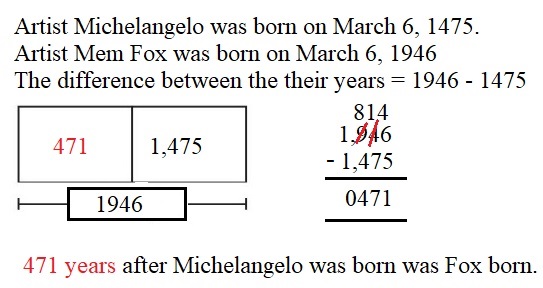
Question 4.
During the month of March, 68,025 pounds of king crab were caught. If 15,614 pounds were caught in the first week of March, how many pounds were caught in the rest of the month?
Answer:
Number of pounds of king crabs caught in the month of March = 68,025 pounds.
Number of pounds of king crabs caught in the first week of March = 15,614 pounds.
Number of pounds were caught in the rest of the month = 68,025 – 15,614 = 52,411.

Question 5.
James bought a used car. After driving exactly 9,050 miles, the odometer read 118,064 miles. What was the odometer reading when James bought the car?
Answer:
James bought a used car after driving exactly = 9,050 miles.
The reading of the Odometer = 118,064 miles.
The odometer reading when James bought the car = 118,064 – 9,050 =
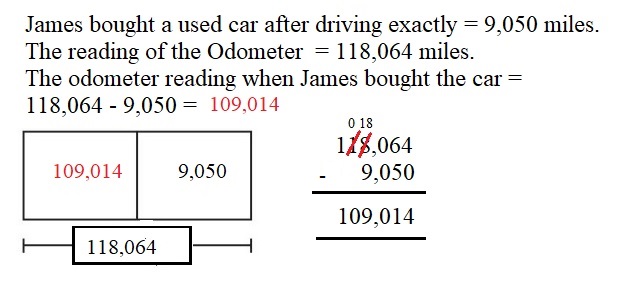
Eureka Math Grade 4 Module 1 Lesson 13 Exit Ticket Answer Key
Question 1.
Use the standard algorithm to solve the following subtraction problems.
a. 
Answer:
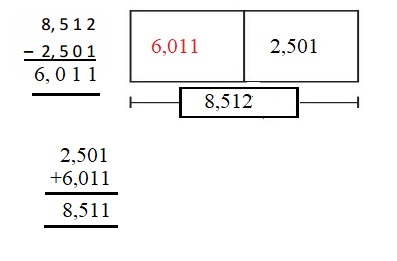
Explanation:
The rules of subtraction we first write the greater number at the top. Then subtract the digits column-wise ones from ones, tens from tens, hundreds from hundreds, thousands from thousands and so on.
Ones = 2 – 1 = 1.
Tens = 1 – 0 = 1.
Hundreds = 5 – 5 = 0.
Thousands = 8 – 2 = 6.
The number 8,512 is the minuend, the number 2,501 is the subtrahend and the number 6,011 is the difference.
b. 
Answer:
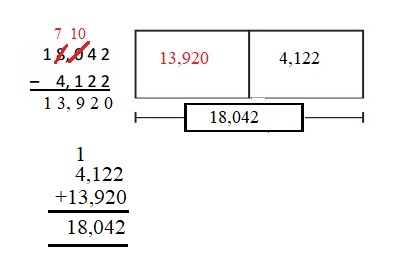
Explanation:
The rules of subtraction we first write the greater number at the top. Then subtract the digits column-wise ones from ones, tens from tens, hundreds from hundreds, thousands from thousands and so on.
Ones = 2 – 2 = 0.
Tens = 4 – 2 = 2.
Hundreds = 0 – 1 = 10 – 1 = 9.
0 is less than 1 so we borrow 1 from the 8 thousands place and make 8 thousands as 7 thousands and make 0 hundred as 10 hundred and we subtract 1 from 10.
Thousands = 7 – 4 = 3.
Ten thousand =1.
The number 18,042 is the minuend, the number 4,122 is the subtrahend and the number 13,920 is the difference.
c. 
Answer:

Explanation:
The rules of subtraction we first write the greater number at the top. Then subtract the digits column-wise ones from ones, tens from tens, hundreds from hundreds, thousands from thousands and so on.
Ones = 2 – 1 = 1.
Tens = 7- 6 = 1.
Hundreds = 0 – 5 = 10 – 5 = 5.
0 is less than 5 so we borrow 1 from the 8 thousands place and make 8 thousands as 7 thousands and make 0 hundred as 10 hundred and we subtract 5 from 10.
Thousands = 7 – 1 = 6.
The number 8,072 is the minuend, the number 1,561 is the subtrahend and the number 6,511 is the difference.
Draw a tape diagram to represent the following problem. Use numbers to solve. Write your answer as a statement. Check your answer.
Question 2.
What number must be added to 1,575 to result in a sum of 8,625?
Answer:
Sum = 8,625
One Addend = 1,575
Second Addend = sum – one addend = 8,625 – 1,575 =
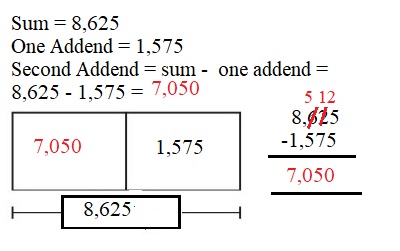
Eureka Math Grade 4 Module 1 Lesson 13 Homework Answer Key
Question 1.
Use the standard algorithm to solve the following subtraction problems.
a. 
Answer:

b. 
Answer:

c. 
Answer:

d. 
Answer:

e. 
Answer:

f. 
Answer:

g. 2,431 – 920 =
Answer:

h. 892,431 – 520,800 =
Answer:

Question 2.
What number must be added to 14,056 to result in a sum of 38,773?
Answer:
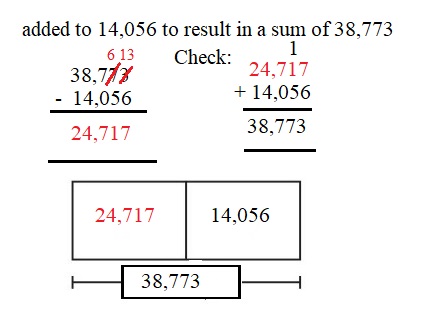
Draw a tape diagram to model each problem. Use numbers to solve, and write your answers as a statement. Check your answers.
Question 3.
An elementary school collected 1,705 bottles for a recycling program. A high school also collected some bottles. Both schools collected 3,627 bottles combined. How many bottles did the high school collect?
Answer:

The High School have collected 1,922 bottles.
Question 4.
A computer shop sold $356,291 worth of computers and accessories. It sold $43,720 worth of accessories. How much did the computer shop sell in computers?
Answer:
Total worth of computers and accessories a computer shop = $356,291
The worth of accessories = $43,720.
The worth of computers = A
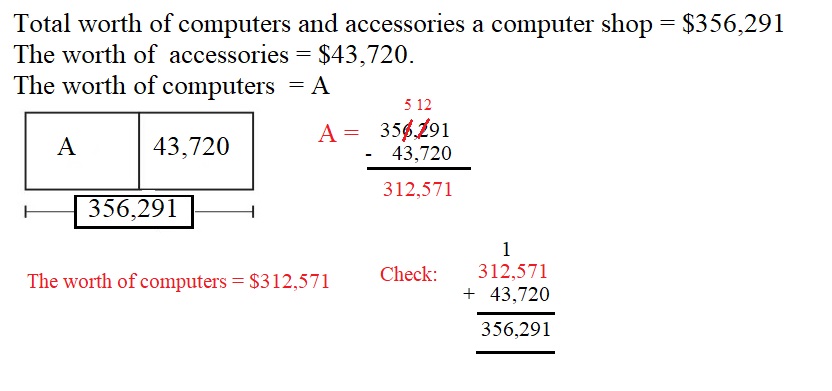
Question 5.
The population of a city is 538,381. In that population, 148,170 are children.
a. How many adults live in the city?
b. 186,101 of the adults are males. How many adults are female?
Answer:
Total population of the city = 538,381
Number of children in the city = 148,170
Answer:
